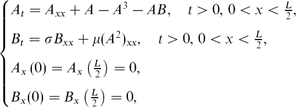Article contents
Stability of patterns with arbitrary period for a Ginzburg-Landau equation with a mean field
Published online by Cambridge University Press: 01 April 2007
Abstract
We consider the following system of equations:
 where the spatial average ⟨ B ⟩ = 0 and μ > σ > 0. This system plays an important role as a Ginzburg-Landau equation with a mean field in several areas of the applied sciences and the steady-states of this system extend to periodic steady-states with period L on the real line which are observed in experiments. Our approach is by combining methods of nonlinear functional analysis such as nonlocal eigenvalue problems and the variational characterization of eigenvalues with Jacobi elliptic integrals. This enables us to give a complete classification of all stable steady-states for any positive L.
where the spatial average ⟨ B ⟩ = 0 and μ > σ > 0. This system plays an important role as a Ginzburg-Landau equation with a mean field in several areas of the applied sciences and the steady-states of this system extend to periodic steady-states with period L on the real line which are observed in experiments. Our approach is by combining methods of nonlinear functional analysis such as nonlocal eigenvalue problems and the variational characterization of eigenvalues with Jacobi elliptic integrals. This enables us to give a complete classification of all stable steady-states for any positive L.
- Type
- Papers
- Information
- Copyright
- Copyright © Cambridge University Press 2007
References
- 3
- Cited by




